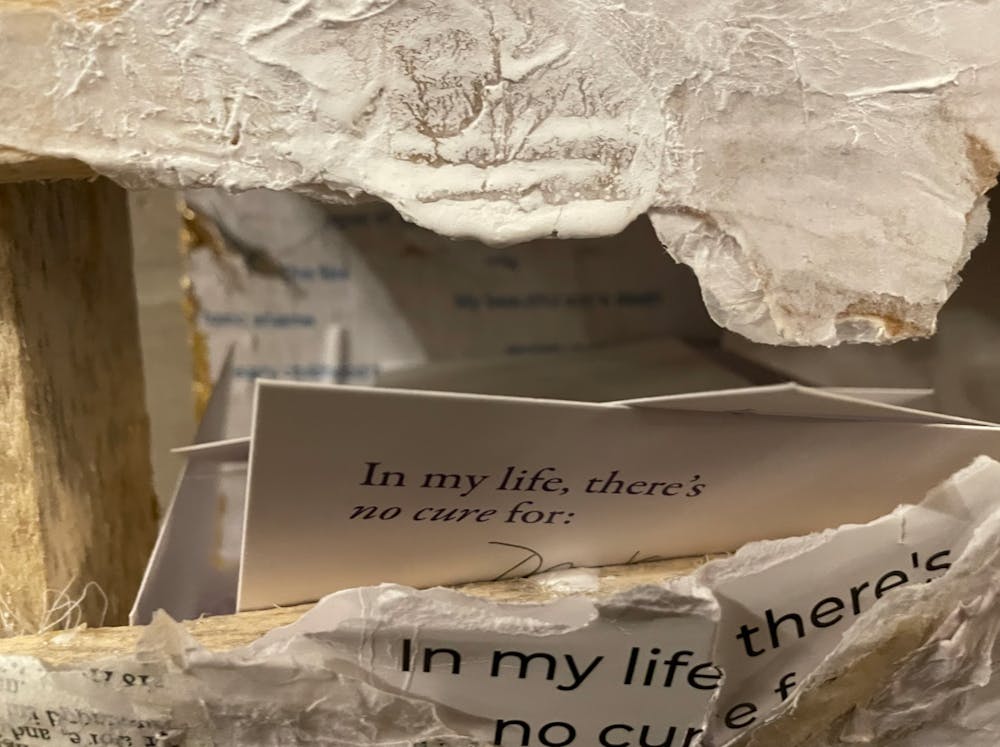In response to a scene in Duke Divinity professor Kate Bowler’s book “No Cure for Being Human (And Other Truths I Need to Hear),” Lanecia Rouse Tinsley, MDiv ‘03, was inspired to create the installation “Reliquary of Complicated Truths,” which is on view in the Duke Chapel through tomorrow.
In a conversation between Bowler and Tinsley, Bowler described a scene from her book where she was “on a trip to the Grand Canyon when she [came] upon a remote chapel … covered in graffiti and slips of paper inserted in the walls with written pleas from the heart, such as ‘I miss you every day’ and ‘Did you make it to heaven, my love?’”
The interactive installation at the heart of Tinsley’s exhibition draws directly from this scene. It invites visitors to insert cards with their own response to the prompt: “In my life, there is no cure for…” into a crack. In this piece, viewers see clippings of paper texts and images plastered on a discarded cardboard box. White paint coats the surface of the cardboard box. The juxtaposition of barely visible words already on the box and words written down by visitors mirrors the myriad of interactions between the existing cultures and people’s idiosyncrasies.
Another piece, “Solitude,” features a wood crate with a crack in the bottom left corner, which exposes the image of a person burying their head in their knees, all alone, faceless. When standing directly in front of this piece, viewers only see the silhouette of the solitary individual, wooden texture enclosing them from all sides. As the viewers shift their perspectives to the rear angles, they notice that the space the lone person occupies is no longer suffocating and wooden, but ambient.
A third memorable piece is “Unknown Cries”. This installation exemplifies both human souls’ distance and connection, one aspect that weaves into the complex truth in this world. The audience only has access to the man’s facial expression — he is shedding tears. But they cannot know why he is crying. Even though no one can fully understand another person, we are connected by our shared emotions such as grief. We can empathize with one another whatever the reason for our tears.
The works in “Reliquary of Complicated Truths” are tangible metaphors, telling the viewers that discarded, seemingly useless material can be pieced together and transformed into art, just as mundanity and brokenness can be reconfigured into something beautiful.
What is the ingredient, the magic, needed for this transformation? In Tinsley’s view, it is hope. In conversation with Bowler, she touched upon the power of hope.
“It seems that America has only one story — each of us are the ‘invincible chooser’ in our lives,” Tinsley said. Countering this singular narrative, she argued that in life we are faced with countless limitations, that we are not creatures of fully our own wills.
Hope, however, uplifts us above our human bounds. Accepting our limitations but embracing hope allows us to “be wowed” by the beauty of life and believe that “better things are possible” despite the pain and struggles, Tinsley said. “[Hope let us] see the night stars amidst the dark sky.”
“Reliquary of Complicated Truths” is on view in the Duke Chapel from 10:00 am to 8:00 pm through March 1.
Get The Chronicle straight to your inbox
Signup for our weekly newsletter. Cancel at any time.
Katherine Zhong is a Trinity junior and local arts editor of The Chronicle's 119th volume.

